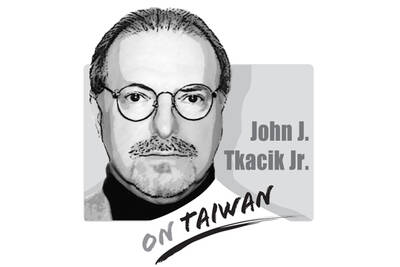An alliance of pro-localization groups, formed to oppose the exclusive use of Hanyu pinyin to translate station names into English on the Taiwan Taoyuan International Airport Mass Rapid Transit (MRT) line, protested outside the Ministry of Education in Taipei on Tuesday last week.
“The romanization used on road signs and public transport is intended for foreigners. Every foreigner learning Mandarin learns Hanyu pinyin, because it is the international standard. The decision has nothing to do with the nation’s self-determination or any ideologies, because the point is to ensure that foreigners can read the signs,” an official from the ministry said, responding to the protest.
The use of Hanyu pinyin for place names and street signs is nothing more than a tool to aid understanding and has nothing to do with politics, according to the ministry.
Following this logic, since only a minority of the world’s “foreigners” speak Chinese, only a minority learn Hanyu pinyin, which is somewhat different from English phonetics. For example, in Hanyu pinyin the letter “x” is used to pronounce the Chinese character 西 (xi), rather than “si,” which is closer to how it sounds in English.
The romanized names on the Taoyuan airport MRT are there for the benefit of all foreigners, not just those who understand Chinese. If a foreigner understands Chinese, they are able to read Chinese characters and therefore probably do not need to read any form of pinyn.
Since Taiwan’s Tongyong pinyin is closer to how English is actually pronounced and spoken around the world, — it uses “si” instead of “xi” — the new MRT line should use Tongyong pinyin. Kaohsiung’s MRT has used Tongyong pinyin for many years, yet foreign visitors and residents have no problem navigating the system.
If we follow the logic of the ministry, it should recommend to China that its airport metro systems use Tongyong pinyin, since the romanization of station names on China’s metro systems is for the benefit of all foreigners around the world, not just those who understand Chinese.
One suspects that the Chinese government would have something to say about that.
It would probably state unequivocally that Hanyu pinyin forms a part of the official language of China, it is a sovereign matter and that Chinese metro systems will not be using Tongyong pinyin.
Calling on Chinese metro systems to adopt Tongyong pinyin, based on the notion that the romanization of place names and street names has nothing to do with politics would — quite rightly — be seen as political interference in China’s internal affairs — and a violation of basic international norms.
A sound language policy should strike a balance between the competing arguments of language as identity and language as a tool.
In 2002 then-premier Yu Shyi-kun approved the use of Tongyong pinyin. Why does the ministry still insist on rolling out the extreme and highly ideological argument of Hanyu pinyin as “purely a linguistic tool”?
Liu Chien-kuo, Chen Ting-fei, Kuan Bi-ling and Cheng Pao-ching are Democratic Progressive Party legislators.
Translated by Edward Jones

Elbridge Colby, America’s Under Secretary of Defense for Policy, is the most influential voice on defense strategy in the Second Trump Administration. For insight into his thinking, one could do no better than read his thoughts on the defense of Taiwan which he gathered in a book he wrote in 2021. The Strategy of Denial, is his contemplation of China’s rising hegemony in Asia and on how to deter China from invading Taiwan. Allowing China to absorb Taiwan, he wrote, would open the entire Indo-Pacific region to Chinese preeminence and result in a power transition that would place America’s prosperity
When Democratic Progressive Party (DPP) caucus whip Ker Chien-ming (柯建銘) first suggested a mass recall of Chinese Nationalist Party (KMT) legislators, the Taipei Times called the idea “not only absurd, but also deeply undemocratic” (“Lai’s speech and legislative chaos,” Jan. 6, page 8). In a subsequent editorial (“Recall chaos plays into KMT hands,” Jan. 9, page 8), the paper wrote that his suggestion was not a solution, and that if it failed, it would exacerbate the enmity between the parties and lead to a cascade of revenge recalls. The danger came from having the DPP orchestrate a mass recall. As it transpired,
A few weeks ago in Kaohsiung, tech mogul turned political pundit Robert Tsao (曹興誠) joined Western Washington University professor Chen Shih-fen (陳時奮) for a public forum in support of Taiwan’s recall campaign. Kaohsiung, already the most Taiwanese independence-minded city in Taiwan, was not in need of a recall. So Chen took a different approach: He made the case that unification with China would be too expensive to work. The argument was unusual. Most of the time, we hear that Taiwan should remain free out of respect for democracy and self-determination, but cost? That is not part of the usual script, and
All 24 Chinese Nationalist Party (KMT) lawmakers and suspended Hsinchu Mayor Ann Kao (高虹安), formerly of the Taiwan People’s Party (TPP), survived recall elections against them on Saturday, in a massive loss to the unprecedented mass recall movement, as well as to the ruling Democratic Progressive Party (DPP) that backed it. The outcome has surprised many, as most analysts expected that at least a few legislators would be ousted. Over the past few months, dedicated and passionate civic groups gathered more than 1 million signatures to recall KMT lawmakers, an extraordinary achievement that many believed would be enough to remove at